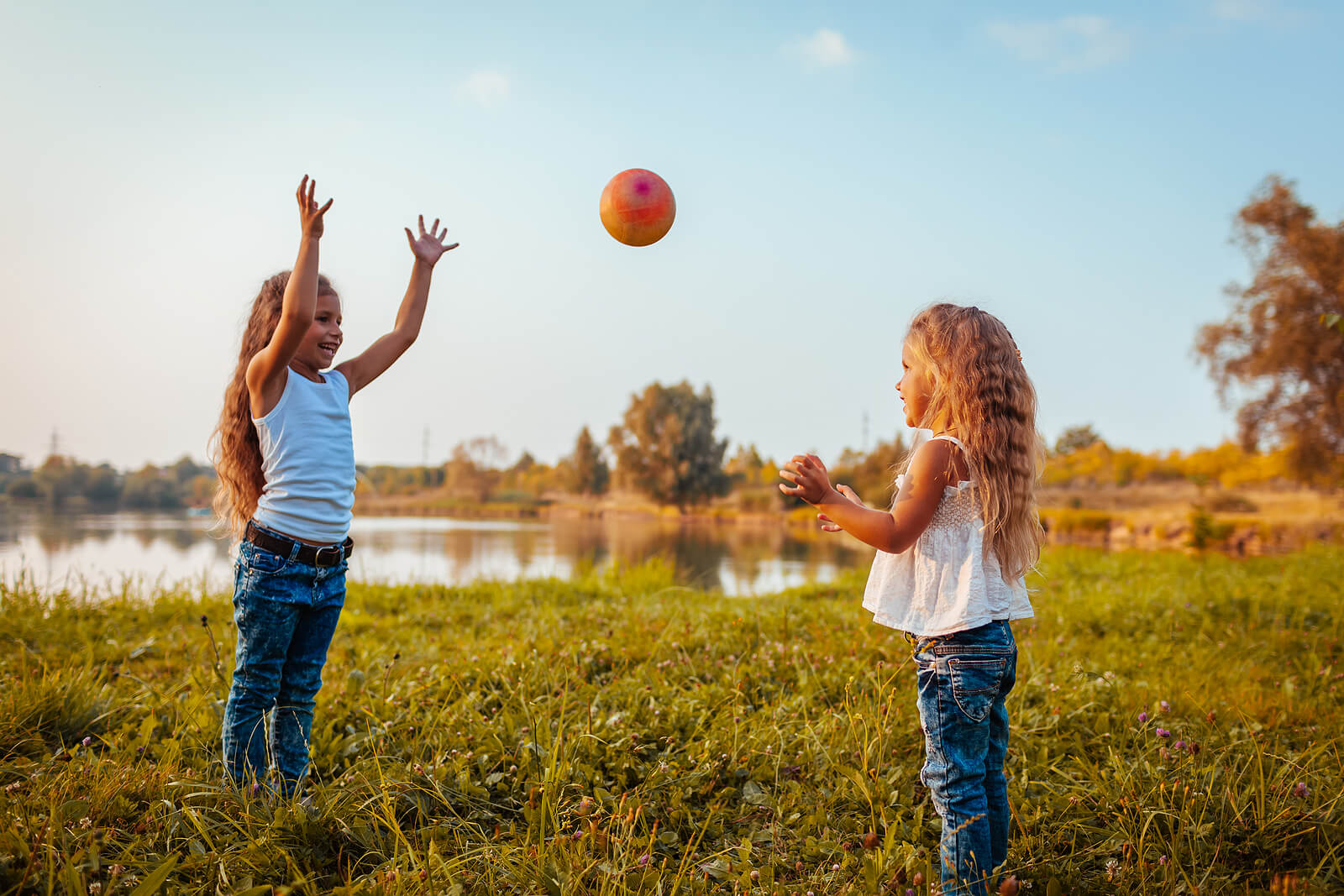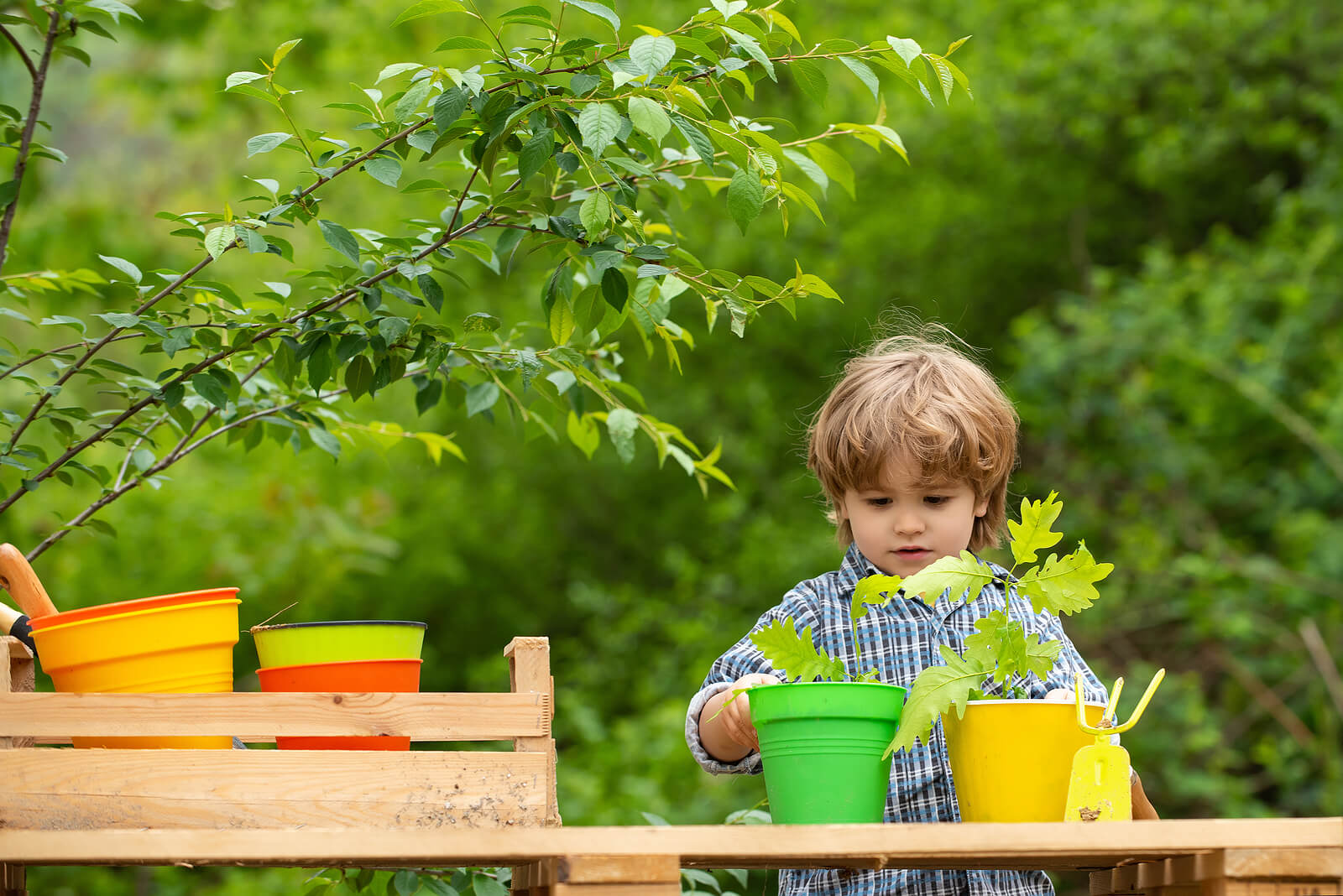13 Activities to Improve Hand-Eye Coordination in Young Children


Written and verified by the psychopedagogue María José Roldán
These games and activities are simple, quick, and exercise the brain’s ability to coordinate the hands and eyes simultaneously. Here are some activities that are great for improving hand-eye coordination in young children. Also, they allow kids to have a great time!
Doing an activity a day that lasts about 5 minutes, without you even realizing it, will have a great impact on your child’s motor development. Later, this will help you learn to read and write more effectively. As you’ll see, they’re simple activities, but they’ll help your little one to develop their hand-eye coordination in a correct way.
Activities to improve hand-eye coordination in young children

1. Throw and catch a ball
This is probably the best way to improve hand-eye coordination in young children. You should practice catching and throwing balls often, as this is also a skill you’ll need when your child starts playing sports.
To carry out this activity, you can use balls of different sizes, such as tennis balls, basketballs, beach balls… Throwing and catching smaller balls requires more advanced skills.
2. Have a pillow fight to improve hand-eye coordination
This is an activity that children will love. Throwing pillows and working with your eyes, hands, and laughter at the same time is the most fun. You’ll spend a wonderful time full of laughter among all.
3. Threading and lacing
Threading and lacing are great for developing concentration and for practicing controlled movements. Your child must coordinate their eyes and fingers carefully to complete this task. So, create your own threading or interlacing cards by using cardboard shapes and punching holes in them or by using a set of interlacing cards.
Threading and tying are two of the best activities your little one can do to develop fine motor skills. In addition, you’ll have a good time together while doing a quiet activity.
4. Gardening with children for hand-eye coordination
Gardening is a great way to get outside while developing coordination and overall gross motor skills. All you need are some gardening tools and you’re good to go.

5. Bowling to improve hand-eye coordination in young children
Create your own bowling pins by filling large plastic bottles with a little water and painting them in various colors. Then, line them up and take turns with your child to roll a ball and knock them down. As your little one gets more skilled, use smaller bottles. You can also buy a toy bowling set.
6. Puzzles
Puzzles are one of the best activities for your child. They develop skills such as fine motor skills, shape recognition (pre-mathematics), problem-solving, logic, attention, and of course hand-eye coordination. Choose wooden puzzles as they’re sturdier and easier to handle, especially for toddlers.
7. Balloon launch
Blow up a small or large balloon and see how long your child can keep it in the air while hitting it. This is great for developing coordination, as it requires moving and thinking quickly to keep the balloon from falling. What’s more, it requires using your eyes and hands simultaneously.
8. Sandbox toys
At the same time, playing in the sandbox by filling containers with sand and building sand structures can provide a lot of practice for developing coordination. Offer your little one buckets and containers of different sizes, as well as tools like shovels and rakes.
9. Cut and paste to improve hand-eye coordination
Give your child different types of paper, such as newspaper, tissue paper, cardboard, etc., and let them cut it into shapes or strips. Also, provide glue such as liquid wood glue, craft glue, a stick, or even a flour and water mixture with some brushes to spread the glue. This activity will require a lot of supervision because of the type of materials that are used.
10. Jump rope
Jumping is a challenging skill that many children have a hard time doing, but it’s great for improving coordination. Children not only have to coordinate both sides of their body and alternate legs, but they also need to move the jump rope while making sure to see that they jump through the rope.

11. Draw
Your children should spend time drawing every day. It’s a basic activity that helps to develop hand-eye coordination very well; the eyes and fingers work at the same time to perform the same task. To do this, provide different utensils and media such as, for example, paper, cardboard, blackboard, pencils, wax colors, tempera paints, etc.
12. Blackboard and chalk for hand-eye coordination
A large blackboard gives your child the opportunity to draw while working their large muscles. They also have to cross their arms to reach the left and right of the board, which develops their ability to cross the midline of the body. Get a standing board or stick a large sheet of paper on the wall to provide a similar experience.
13. Finger painting
This activity gives children the opportunity to have a sensory experience and helps develop hand-eye coordination. Create your own finger paint at home or buy it ready-made, whatever you want! Your children will love learning while they put their hands in the paint. They will be very messy and fun moments for your little ones.
As you can see, there are many activities that you can do with your children at home and with easily available materials. As if that weren’t enough, you’ll have a wonderful time together doing these tasks. What are you waiting for to put them into practice?
These games and activities are simple, quick, and exercise the brain’s ability to coordinate the hands and eyes simultaneously. Here are some activities that are great for improving hand-eye coordination in young children. Also, they allow kids to have a great time!
Doing an activity a day that lasts about 5 minutes, without you even realizing it, will have a great impact on your child’s motor development. Later, this will help you learn to read and write more effectively. As you’ll see, they’re simple activities, but they’ll help your little one to develop their hand-eye coordination in a correct way.
Activities to improve hand-eye coordination in young children

1. Throw and catch a ball
This is probably the best way to improve hand-eye coordination in young children. You should practice catching and throwing balls often, as this is also a skill you’ll need when your child starts playing sports.
To carry out this activity, you can use balls of different sizes, such as tennis balls, basketballs, beach balls… Throwing and catching smaller balls requires more advanced skills.
2. Have a pillow fight to improve hand-eye coordination
This is an activity that children will love. Throwing pillows and working with your eyes, hands, and laughter at the same time is the most fun. You’ll spend a wonderful time full of laughter among all.
3. Threading and lacing
Threading and lacing are great for developing concentration and for practicing controlled movements. Your child must coordinate their eyes and fingers carefully to complete this task. So, create your own threading or interlacing cards by using cardboard shapes and punching holes in them or by using a set of interlacing cards.
Threading and tying are two of the best activities your little one can do to develop fine motor skills. In addition, you’ll have a good time together while doing a quiet activity.
4. Gardening with children for hand-eye coordination
Gardening is a great way to get outside while developing coordination and overall gross motor skills. All you need are some gardening tools and you’re good to go.

5. Bowling to improve hand-eye coordination in young children
Create your own bowling pins by filling large plastic bottles with a little water and painting them in various colors. Then, line them up and take turns with your child to roll a ball and knock them down. As your little one gets more skilled, use smaller bottles. You can also buy a toy bowling set.
6. Puzzles
Puzzles are one of the best activities for your child. They develop skills such as fine motor skills, shape recognition (pre-mathematics), problem-solving, logic, attention, and of course hand-eye coordination. Choose wooden puzzles as they’re sturdier and easier to handle, especially for toddlers.
7. Balloon launch
Blow up a small or large balloon and see how long your child can keep it in the air while hitting it. This is great for developing coordination, as it requires moving and thinking quickly to keep the balloon from falling. What’s more, it requires using your eyes and hands simultaneously.
8. Sandbox toys
At the same time, playing in the sandbox by filling containers with sand and building sand structures can provide a lot of practice for developing coordination. Offer your little one buckets and containers of different sizes, as well as tools like shovels and rakes.
9. Cut and paste to improve hand-eye coordination
Give your child different types of paper, such as newspaper, tissue paper, cardboard, etc., and let them cut it into shapes or strips. Also, provide glue such as liquid wood glue, craft glue, a stick, or even a flour and water mixture with some brushes to spread the glue. This activity will require a lot of supervision because of the type of materials that are used.
10. Jump rope
Jumping is a challenging skill that many children have a hard time doing, but it’s great for improving coordination. Children not only have to coordinate both sides of their body and alternate legs, but they also need to move the jump rope while making sure to see that they jump through the rope.

11. Draw
Your children should spend time drawing every day. It’s a basic activity that helps to develop hand-eye coordination very well; the eyes and fingers work at the same time to perform the same task. To do this, provide different utensils and media such as, for example, paper, cardboard, blackboard, pencils, wax colors, tempera paints, etc.
12. Blackboard and chalk for hand-eye coordination
A large blackboard gives your child the opportunity to draw while working their large muscles. They also have to cross their arms to reach the left and right of the board, which develops their ability to cross the midline of the body. Get a standing board or stick a large sheet of paper on the wall to provide a similar experience.
13. Finger painting
This activity gives children the opportunity to have a sensory experience and helps develop hand-eye coordination. Create your own finger paint at home or buy it ready-made, whatever you want! Your children will love learning while they put their hands in the paint. They will be very messy and fun moments for your little ones.
As you can see, there are many activities that you can do with your children at home and with easily available materials. As if that weren’t enough, you’ll have a wonderful time together doing these tasks. What are you waiting for to put them into practice?
All cited sources were thoroughly reviewed by our team to ensure their quality, reliability, currency, and validity. The bibliography of this article was considered reliable and of academic or scientific accuracy.
- Muñoz García, A. ( 2010). Por qué jugar con bloques es bueno para niños pequeños. En: Psicología del desarrollo en la etapa de educación infantil. Editorial: Pirámide.
- Ramírez Calixto, Carmita Yisela, Arteaga Rolando, Mary América, & Luna Alvarez, Heriberto Enrique. (2020). Las habilidades de coordinación visomotriz para el aprendizaje de la escritura. Revista Universidad y Sociedad, 12(1), 116-120. Epub 02 de febrero de 2020. Recuperado en 08 de marzo de 2022, de http://scielo.sld.cu/scielo.php?script=sci_arttext&pid=S2218-36202020000100116&lng=es&tlng=es.
This text is provided for informational purposes only and does not replace consultation with a professional. If in doubt, consult your specialist.








